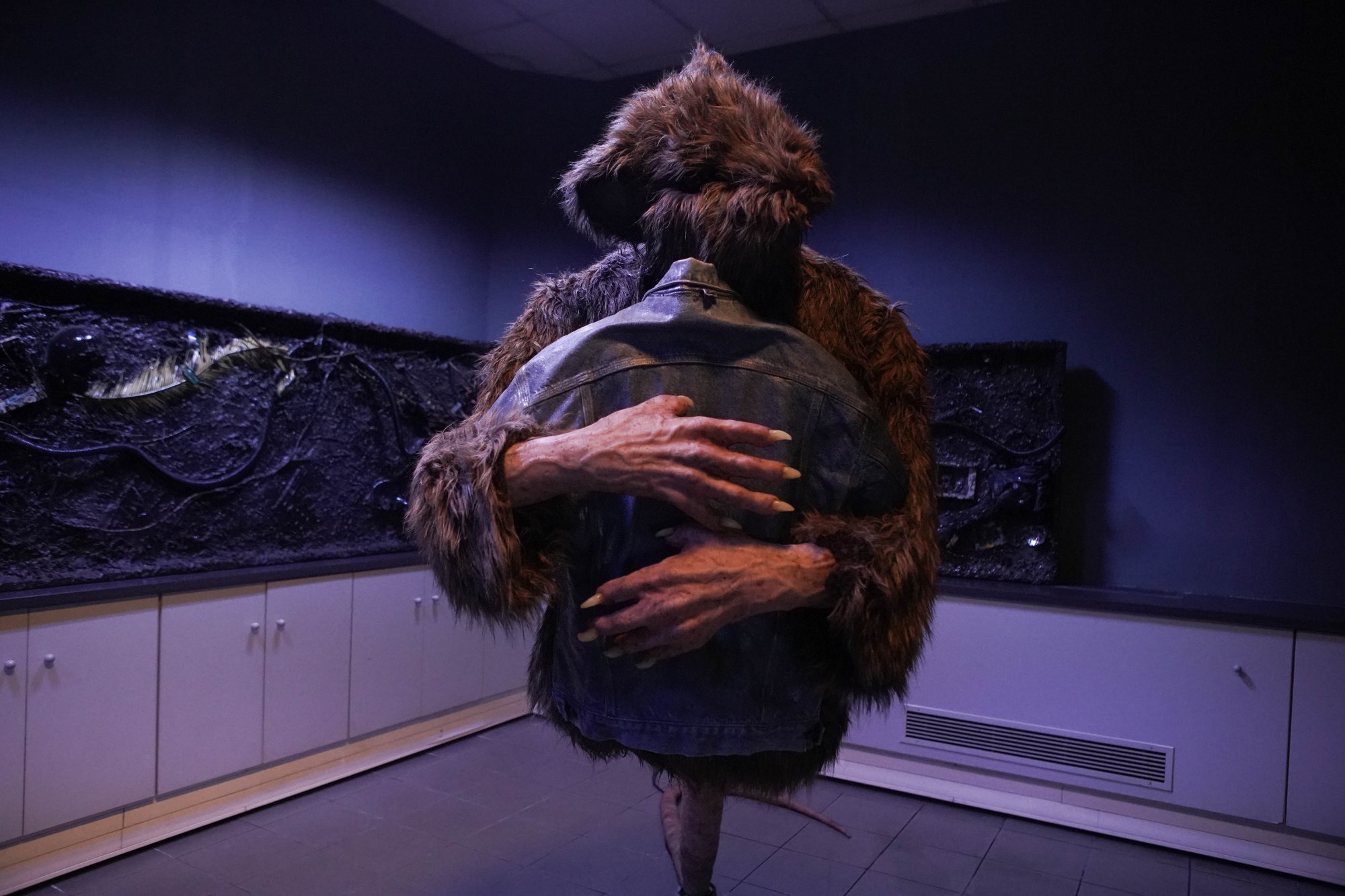6. Athens Biennale 2018
ANTI
26 Oct - 09 Dec 2018

Anna Uddenberg: Dom Depot, installation view at the 6th Athens Biennale 2018, photo Nysos Vasilopoulos

Pinar Öğrenci: LED Light City Istanbul, installation view at the 6th Athens Biennale 2018, photo Nysos Vasilopoulos

Michail Pirgelis: Memory Games, installation view at the 6th Athens Biennale 2018, photo Nysos Vasilopoulos

Monira Al Qadiri: The Craft, installation view at the 6th Athens Biennale 2018, photo Nysos Vasilopoulos

Cao Fei: Rumba II Nomad, installation view at the 6th Athens Biennale 2018, photo Nysos Vasilopoulos

Danielle Dean: Trainers, installation view at the 6th Athens Biennale 2018, photo Nysos Vasilopoulos

Korakrit Arunanondchai: There’s a word I’m trying to remember from a feeling I’m about to have (let the song hold us), installation view at the 6th Athens Biennale 2018, photo Nysos Vasilopoulos

Sarawut Chutiwongpeti: Wishes, Lies and Dreams Anti-Colonial Power, installation view at the 6th Athens Biennale 2018, photo Nysos Vasilopoulos

Tabita Rezaire: Sugar Walls Teardom, installation view at the 6th Athens Biennale 2018, photo Nysos Vasilopoulos

Aliza Shvarts: How does it feel to be a fiction, Athens Virus, installation view at the 6th Athens Biennale 2018, photo Nysos Vasilopoulos
6th ATHENS BIENNALE
ANTI
Curators: Stefanie Hessler / Poka-Yio / Kostis Stafylakis
Full curatorial statements and artist list:
Enter ANTI: ANTI is a preposition, a position, a person. ANTI is indulgent, ascetic, libertarian. ANTI invests in bitcoins and detests political correctness. ΑΝΤΙ is a contraestablishment politicia, a humanist, a creature of our time.
The 6th Athens Biennale flirts with the term, the attitude, the (im)possibility of ANTI. It asks: How does opposition play out today? And what kinds of identities does it forge? At present, an oppositional stance, an attitude of ANTI—an “antitude”—seems to encompass wide arenas of social life including cultural expressions, identity politics, art labor, media and scripted protagonist impersonations on Netflix as well as “weird advertising”, videogames and music video productions. In other words, attitudes of resistance, non-conformity and marginality are rapidly becoming canonized and commodified. ANTI is adored and detested as pre-eminent role model. The imagery of the cunning villain, the proactive manipulator, the taboo perpetrator, is one of today’s most fascinating characters in institutional and counter-establishment politics, tactical resistance and pop culture.
ANTI is becoming normalized.
The mainstreaming of ANTI takes on diverse, ambiguous and often incommensurable manifestations. They range from dreadful to delightful and everything in between. Ambiguous and inconsistent, ANTI testifies for an anew collapse of “markers of certainty” today. Appearing as a self-fortifying propensity, ANTI signals the curl of the political, structural dislocations and bursts of antagonisms. “Antitudes” corroborate as the option to customize your favorite war hero on the first-person shooter game Call of Duty. Conversely, and to contrary effect, they may also surface in the empowering celebration of “Black aesthetics” in Beyoncé’s visual album Lemonade.
Accelerating polarizations have been recognized as driving force of the political, cultural and social climate for decades. In the 1930s, the anthropologist and cyberneticist Gregory Bateson described schismogenesis—the creation of division—as taking the form of mutually amplifying, opposing curves and contrary corners intensifying the reaction of individuals to other individuals, and groups to other groups. Behavioral patterns considered adequate or successful evoke assertion on behalf of a dominant group, and compliant conduct in another group, leading to further domination on one side, and additional submissiveness on the other. Eventually, this mutual incitement leads to rifts and severe divisions. Reciprocally magnifying patterns can also evolve symmetrically, with behavior of each group eliciting similar, competitive conduct from the other group. And it can take the form of a reverse spiral of holding each other back rather than inciting each other. Bateson regarded schismogenesis as the basis of human behavior. He described it as a potent factor for both war and love.
While mechanical, dialectic functionalism has convincingly been rejected since Bateson, to comprehend today’s thriving adversarial attitudes, it may be worth revisiting some 20th century thought constructs rooted in oppositions. Today, we might ask how schismogenesis is stirred in a neo-behaviorist present shaped by digital cybernetics, echo chambers, algorithmic revamping and digital warfare. The answer lies, perhaps, in the most obscure territories of “social” media. Here, the world is turned back to front as if it were a Bizarro comic strip. In these precursors of memes, popular super hero cartoon characters are being transmuted into their obscene alter egos. Memes may be the faces of today’s reverse spirals, digital cul-de-sacs, LOL nihilism and passive-aggressive —as well as at times overtly aggressive—predicaments of a world unhinged.
ANTI is your next door neighbor. ANTI is your social media activism. ANTI is your cute cat video on loop.
ANTI inhabits both power and resistance. This has been painfully realized by countercultural movements from the 1960s and 70s, being turned into proto-types for theories of neo-management, and by supporters of Anonymous, realizing the innocuous revolutionaries’ Janus face in form of hate-mongering internet trolls. ANTI can effortlessly inhabit the reactionary; yet, at the same time we tend to forget that reactionary thinking and politics have their own tradition of radicalism, referred to by some of their most infamous proponents as “conservative revolution” and “radical traditionalism”. It is terrifying that conspiracy theorists, anti-Semites, misogynists and racists have been gaining increasing access to both grassroots politics and mainstream political arenas. The recurring allure of “classical” reactionary thinking can be finely observed in the brief, yet symbolic, appointment of Steve Bannon in Donald Trump’s cabinet, or in the influence of obscure conservatives, such as Aleksandr Dugin, on think tanks of Russian geopolitical strategies. Today, ANTI often appears in disguise of the pan-secessionist fantasy of a return to some form of authentic, ethnic, well-rooted and self-evident community.
ANTI’s “truth”.
What can we infer from today’s radicalized visions prompting fissures and fragmentation as well as the return to localized, navel-gazing lifestyles and compartmentalized political communities? The 6th Athens Biennale does not seek to merely outline such reactionary fantasies; we cannot confront reactionary culture and politics with yet another ANTI. Nor can we decipher the passions of the post-truth era by returning to a humanism of “truth”, “reason” and “enlightenment”. To encounter ANTI means to oscillate between power and revolt, and sometimes dwelling on the in-betweens. By interiorizing and cannibalizing or distorting both, we do not immediately aspire to sublate or transgress them. This biennial aims to instigate the experience of ambiguity, polarity and contrariness inherent in ANTI by lubricating its absurd personifications. The exhibition device becomes a purgatory without a purge.
ANTI-human.
The 6th Athens Biennale sets to challenge our faith in emancipation and humanism by doubting prevalent resurrections of ideas of the “human”. While some have subscribed to post-humanism and others celebrate the future shared by trans-humanists, the exhibition revisits anti-humanism as a discrete area of philosophical positioning rather than a historical trend superseded by post-humanism. To find ANTI in anti-humanism, we need to reread Louis Althusser’s notorious 1964 essay “Marxism and Humanism”. Just as Althusser criticized the socialist humanism of his time, for exacerbating the exact predicaments it intended to alleviate, ANTI aspires to critically rethink recent appeals to the human, including new omniferous, if viable, terminologies such as the Anthropocene (for post-humanists), or “new Cambrian” revolution (for trans-humanist Silicon Valley libertarians dreaming of singularity, immortality and tax-havens on offshore sea-lands).
It seems as if humanism, i.e. a certain humanist ideology, survives, even if perpetually challenged, in the age of post-humanism and trans-humanism. Today’s humanist credo asserts itself as a “real humanism”, beyond illusory and utopian aspirations of the past, working with real matter, palpable desires and fit-for-all—or fit-for-few— developments. This ideology generates its own negation, or opposition, in the form of a dystopian critique of society and inequality: if synthetic cells, artificial life prolongation and cognition enhancing smart drugs give birth to the post- or trans-human, what remains for those systemically classified as only-humans? This dystopian critique accuses post-humanist acceleration for exacerbating the rift between those that can partake and profit, and those excluded from such developments. Mainstream sci-fi cinema and TV series such as Black Mirror consequently critique, while feeding on, this apocalyptic technological zeitgeist. Yet, anti-humanism may offer that discordant space which unites those who were never considered “human” with those unexcited by the thirst for human essence.
Today’s humanism is ambiguous; it both appeals for “natural” wholesomeness and propagates the transcendence of the “human” by becoming cybernetic alpha beings. Precisely this ambiguity urges a reevaluation of the antihumanist proposition. As such, rethinking anti-humanism may help reclaim both its legacies and futures from aggravating annihilationist tendencies in movements such as Landian Dark Enlightenment and other right-wing accelerationist campaigns. And reconsidering the epistemologies of antihumanism may also challenge the left-accelerationist idea of immanent potential for reappropriation or traversal of the reactionary.
Rooted in the realm of art, the exhibition also seeks viable alternatives to the humanitarianism of today’s artistic humanism. Since the start of the financial crisis, artists, curators and cultural institutions have craved to become “socially relevant”. Greece has been a favored incubator of this humanitarianist urge. Even if honorable, the debate on crisis and resistance to austerity has accommodated a rhetorical collapse between artistic initiatives, ideologies of self-sufficiency, an uncritical fetish of the local, and so on. In its celebration of the literal, where everything is what it says it is, artistic humanism leaves little space for invigorating re-articulations of art practices and their relationship to the political. Delaying the urge for instant conclusions, the biennial poses anti-humanism as a possibility, an interim space in which the respective roles and strategies of art and politics can be renegotiated.
ANTI’s new deities.
ANTI is commonly born as revolt against power. Increasingly, such uprisings involve mystical or conspiratorial understandings of the world. In quasi-theological terms, those revolting often speak of malevolent forces controlling the cosmos: call them speculative finance or reptilian aliens. When “reality” cannot be trusted anymore, emotional states are employed as claims for legitimation. What we are living today may well be the last orgiastic spasms of the (Roman) Empire before entering a period of monastic localism, neo-Feudalism, separationism and emotion, faith and presumption above knowledge. Like modern day ancient or medieval Gnostics, conspiracy theorists, spiritualists and preachers of individual wellness are working to convert others to a secret cosmology, informed by clandestine knowledge purported to unlock the hidden order of things. To them, the world as we know it is in decay: dead matter, an empire in decomposition, the product of incurable alienation. In that respect, neo-reactionaries and ascetic spiritualists share something in common: they strive to expose the artificiality of this prison-world and declare the transition to another universe to come. Respectively, for alt-right fans on 4chan, this is a world to be trolled and laughed at. Kek, the frog-faced meme god, is worshiped as a deity of chaos destined to bring down the regime of political correctness and overall institutional politics as we know them.
From ANTI to instead-of.
If dystopian critique strives to expound the failure of modern utopias, the artists in ANTI thematize reactionary and progressive outcries against contemporary confinements. They ask how, if at all, we can engage in the technologically augmented utopias of today. Rather than assuming a position of critical detachment or dialectic negation, the artistic devices composing the biennial introduce us to the enjoyment and discomfort embodied by opposition, asking what might motivate reactionary fantasies and dwelling on progressive pleasures. Live-action-role-play, or LARP, is a tool deployed by several artists in the exhibition who appropriate its gaming techniques. LARP yields something more than a pressure valve for reality. Rather than cathartic mimesis, it offers protocols for persistently replaying and perplexing the social in ways that are physically demanding, psychologically impactful and often inexpedient. By re-evaluating the possibilities of the mimetic, the works in the biennial scrutinize the role of desire and place it in the atmosphere of contemporary spectacle. Here, mimetic reworking, parafiction and overidentification detune the idea of critical distancing through art. The exhibited works function as structures that mimic and at times amplify the indulgence of reaction, without aspiring to bolster or sublate it. They defy nihilistic sarcasm and LOL escapism by showing other ANTIs, hoping to derail mutually aggravating curves, if penetrating the possibility of exacerbating them.
Lastly, in Greek, ANTI also means instead-of . In seeking a trajectory from ANTI to instead-of, the 6th Athens Biennale highlights attitudes that demand new alternatives in the realms mostly shaping our lives today: from gym to online forum, from church to airport security area, from shopping mall to sex dungeon. These devices invite us to mirror ourselves in the seductive seclusion and fetishistic immersiveness engendered by contemporary technologies and oppositional desires. An instead-of is neither an antithesis, nor post-ironic absolutism. The exhibition summons a heterogeneous cognitive and visceral experience of parafictional and earnest alternatives. By inviting artists and other cultural producers to inhabit situations and devices mimicking, distorting, twisting, or amplifying contemporary lifetheaters, ANTI is the departure point for numerous instead-ofs.
Artists:
Spyros Aggelopoulos
Loukia Alavanou
Monira Al Qadiri
Korakrit Arunanondchai & Alex Gvojic
Ivana Bašić
Tianzhuo Chen
Chim↑Pom
Sarawut Chutiwongpeti
Brody Condon
Celia Daskopoulou
Ted Davis
Danielle Dean
JP Downer
Georgia Fambris
Cao Fei
Ed Fornieles
Ed Fornieles Studios, Omsk Social Club and Nina Runa Essendrop
Angelos Frentzos
Sarah Friend
Front Deutscher Äpfel
Dorota Gawęda and Eglė Kulbokaitė
Eva Giannakopoulou
Gigas
Joey Holder
Carsten Höller
Callum Leo Hughes
Actually Huizenga (of Patriarchy)
Jacob Hurwitz-Goodman & Daniel Keller
Binelde Hyrcan
Maryam Jafri
Sascha Jahn & TheBoundCollective
Jakub Jansa
Geumhyung Jeong
Kahlil Joseph
Florence Jung
Raja’a Khalid
Hara-Joy Kolaitis
Peter V. Kritikos
Laboratory for Microclimates
Euripides Laskaridis / Osmosis
Delaine Le Bas
Candice Lin
Fei Liu
Rachel Maclean
Basim Magdy
Miltos Manetas
Marianne Maric
Eva and Franco Mattes
Metahaven
Quenton Miller
Molleindustria
Shana Moulton
Sirous Namazi
Narcissister
New Models
Pinar Öğrenci
Marisa Olson
Uģis Olte & Morten Traavik
Ilias Papailiakis
Eva Papamargariti
Yuri Pattison
Heather Phillipson
AnnaMaria Pinaka
Wong Ping
Signe Pierce
Michail Pirgelis
Agnieszka Polska
Lykourgos Porfyris
Porpentine Charity Heartscape
Jon Rafman
Johannes Paul Raether
Kosta Rapadopoulos / Jasin Challah
Tabita Rezaire
Roee Rosen
Iepe Rubingh
Saeborg
Tai Shani
Heji Shin
Aliza Shvarts
Helle Siljeholm
Marianna Simnett
Linnéa Sjöberg
Panos Sklavenitis
Marilia Stagkouraki
Jenna Sutela
The Agency
The Domestic Godless
The Peng! Collective
Ryan Trecartin
Theo Triantafyllidis
Anna Uddenberg
Nicole Wermers
Tori Wrånes
Lauren Wy
Lu Yang
Young Boy Dancing Group
Costas Zapas
Zhala
ANTI
Curators: Stefanie Hessler / Poka-Yio / Kostis Stafylakis
Full curatorial statements and artist list:
Enter ANTI: ANTI is a preposition, a position, a person. ANTI is indulgent, ascetic, libertarian. ANTI invests in bitcoins and detests political correctness. ΑΝΤΙ is a contraestablishment politicia, a humanist, a creature of our time.
The 6th Athens Biennale flirts with the term, the attitude, the (im)possibility of ANTI. It asks: How does opposition play out today? And what kinds of identities does it forge? At present, an oppositional stance, an attitude of ANTI—an “antitude”—seems to encompass wide arenas of social life including cultural expressions, identity politics, art labor, media and scripted protagonist impersonations on Netflix as well as “weird advertising”, videogames and music video productions. In other words, attitudes of resistance, non-conformity and marginality are rapidly becoming canonized and commodified. ANTI is adored and detested as pre-eminent role model. The imagery of the cunning villain, the proactive manipulator, the taboo perpetrator, is one of today’s most fascinating characters in institutional and counter-establishment politics, tactical resistance and pop culture.
ANTI is becoming normalized.
The mainstreaming of ANTI takes on diverse, ambiguous and often incommensurable manifestations. They range from dreadful to delightful and everything in between. Ambiguous and inconsistent, ANTI testifies for an anew collapse of “markers of certainty” today. Appearing as a self-fortifying propensity, ANTI signals the curl of the political, structural dislocations and bursts of antagonisms. “Antitudes” corroborate as the option to customize your favorite war hero on the first-person shooter game Call of Duty. Conversely, and to contrary effect, they may also surface in the empowering celebration of “Black aesthetics” in Beyoncé’s visual album Lemonade.
Accelerating polarizations have been recognized as driving force of the political, cultural and social climate for decades. In the 1930s, the anthropologist and cyberneticist Gregory Bateson described schismogenesis—the creation of division—as taking the form of mutually amplifying, opposing curves and contrary corners intensifying the reaction of individuals to other individuals, and groups to other groups. Behavioral patterns considered adequate or successful evoke assertion on behalf of a dominant group, and compliant conduct in another group, leading to further domination on one side, and additional submissiveness on the other. Eventually, this mutual incitement leads to rifts and severe divisions. Reciprocally magnifying patterns can also evolve symmetrically, with behavior of each group eliciting similar, competitive conduct from the other group. And it can take the form of a reverse spiral of holding each other back rather than inciting each other. Bateson regarded schismogenesis as the basis of human behavior. He described it as a potent factor for both war and love.
While mechanical, dialectic functionalism has convincingly been rejected since Bateson, to comprehend today’s thriving adversarial attitudes, it may be worth revisiting some 20th century thought constructs rooted in oppositions. Today, we might ask how schismogenesis is stirred in a neo-behaviorist present shaped by digital cybernetics, echo chambers, algorithmic revamping and digital warfare. The answer lies, perhaps, in the most obscure territories of “social” media. Here, the world is turned back to front as if it were a Bizarro comic strip. In these precursors of memes, popular super hero cartoon characters are being transmuted into their obscene alter egos. Memes may be the faces of today’s reverse spirals, digital cul-de-sacs, LOL nihilism and passive-aggressive —as well as at times overtly aggressive—predicaments of a world unhinged.
ANTI is your next door neighbor. ANTI is your social media activism. ANTI is your cute cat video on loop.
ANTI inhabits both power and resistance. This has been painfully realized by countercultural movements from the 1960s and 70s, being turned into proto-types for theories of neo-management, and by supporters of Anonymous, realizing the innocuous revolutionaries’ Janus face in form of hate-mongering internet trolls. ANTI can effortlessly inhabit the reactionary; yet, at the same time we tend to forget that reactionary thinking and politics have their own tradition of radicalism, referred to by some of their most infamous proponents as “conservative revolution” and “radical traditionalism”. It is terrifying that conspiracy theorists, anti-Semites, misogynists and racists have been gaining increasing access to both grassroots politics and mainstream political arenas. The recurring allure of “classical” reactionary thinking can be finely observed in the brief, yet symbolic, appointment of Steve Bannon in Donald Trump’s cabinet, or in the influence of obscure conservatives, such as Aleksandr Dugin, on think tanks of Russian geopolitical strategies. Today, ANTI often appears in disguise of the pan-secessionist fantasy of a return to some form of authentic, ethnic, well-rooted and self-evident community.
ANTI’s “truth”.
What can we infer from today’s radicalized visions prompting fissures and fragmentation as well as the return to localized, navel-gazing lifestyles and compartmentalized political communities? The 6th Athens Biennale does not seek to merely outline such reactionary fantasies; we cannot confront reactionary culture and politics with yet another ANTI. Nor can we decipher the passions of the post-truth era by returning to a humanism of “truth”, “reason” and “enlightenment”. To encounter ANTI means to oscillate between power and revolt, and sometimes dwelling on the in-betweens. By interiorizing and cannibalizing or distorting both, we do not immediately aspire to sublate or transgress them. This biennial aims to instigate the experience of ambiguity, polarity and contrariness inherent in ANTI by lubricating its absurd personifications. The exhibition device becomes a purgatory without a purge.
ANTI-human.
The 6th Athens Biennale sets to challenge our faith in emancipation and humanism by doubting prevalent resurrections of ideas of the “human”. While some have subscribed to post-humanism and others celebrate the future shared by trans-humanists, the exhibition revisits anti-humanism as a discrete area of philosophical positioning rather than a historical trend superseded by post-humanism. To find ANTI in anti-humanism, we need to reread Louis Althusser’s notorious 1964 essay “Marxism and Humanism”. Just as Althusser criticized the socialist humanism of his time, for exacerbating the exact predicaments it intended to alleviate, ANTI aspires to critically rethink recent appeals to the human, including new omniferous, if viable, terminologies such as the Anthropocene (for post-humanists), or “new Cambrian” revolution (for trans-humanist Silicon Valley libertarians dreaming of singularity, immortality and tax-havens on offshore sea-lands).
It seems as if humanism, i.e. a certain humanist ideology, survives, even if perpetually challenged, in the age of post-humanism and trans-humanism. Today’s humanist credo asserts itself as a “real humanism”, beyond illusory and utopian aspirations of the past, working with real matter, palpable desires and fit-for-all—or fit-for-few— developments. This ideology generates its own negation, or opposition, in the form of a dystopian critique of society and inequality: if synthetic cells, artificial life prolongation and cognition enhancing smart drugs give birth to the post- or trans-human, what remains for those systemically classified as only-humans? This dystopian critique accuses post-humanist acceleration for exacerbating the rift between those that can partake and profit, and those excluded from such developments. Mainstream sci-fi cinema and TV series such as Black Mirror consequently critique, while feeding on, this apocalyptic technological zeitgeist. Yet, anti-humanism may offer that discordant space which unites those who were never considered “human” with those unexcited by the thirst for human essence.
Today’s humanism is ambiguous; it both appeals for “natural” wholesomeness and propagates the transcendence of the “human” by becoming cybernetic alpha beings. Precisely this ambiguity urges a reevaluation of the antihumanist proposition. As such, rethinking anti-humanism may help reclaim both its legacies and futures from aggravating annihilationist tendencies in movements such as Landian Dark Enlightenment and other right-wing accelerationist campaigns. And reconsidering the epistemologies of antihumanism may also challenge the left-accelerationist idea of immanent potential for reappropriation or traversal of the reactionary.
Rooted in the realm of art, the exhibition also seeks viable alternatives to the humanitarianism of today’s artistic humanism. Since the start of the financial crisis, artists, curators and cultural institutions have craved to become “socially relevant”. Greece has been a favored incubator of this humanitarianist urge. Even if honorable, the debate on crisis and resistance to austerity has accommodated a rhetorical collapse between artistic initiatives, ideologies of self-sufficiency, an uncritical fetish of the local, and so on. In its celebration of the literal, where everything is what it says it is, artistic humanism leaves little space for invigorating re-articulations of art practices and their relationship to the political. Delaying the urge for instant conclusions, the biennial poses anti-humanism as a possibility, an interim space in which the respective roles and strategies of art and politics can be renegotiated.
ANTI’s new deities.
ANTI is commonly born as revolt against power. Increasingly, such uprisings involve mystical or conspiratorial understandings of the world. In quasi-theological terms, those revolting often speak of malevolent forces controlling the cosmos: call them speculative finance or reptilian aliens. When “reality” cannot be trusted anymore, emotional states are employed as claims for legitimation. What we are living today may well be the last orgiastic spasms of the (Roman) Empire before entering a period of monastic localism, neo-Feudalism, separationism and emotion, faith and presumption above knowledge. Like modern day ancient or medieval Gnostics, conspiracy theorists, spiritualists and preachers of individual wellness are working to convert others to a secret cosmology, informed by clandestine knowledge purported to unlock the hidden order of things. To them, the world as we know it is in decay: dead matter, an empire in decomposition, the product of incurable alienation. In that respect, neo-reactionaries and ascetic spiritualists share something in common: they strive to expose the artificiality of this prison-world and declare the transition to another universe to come. Respectively, for alt-right fans on 4chan, this is a world to be trolled and laughed at. Kek, the frog-faced meme god, is worshiped as a deity of chaos destined to bring down the regime of political correctness and overall institutional politics as we know them.
From ANTI to instead-of.
If dystopian critique strives to expound the failure of modern utopias, the artists in ANTI thematize reactionary and progressive outcries against contemporary confinements. They ask how, if at all, we can engage in the technologically augmented utopias of today. Rather than assuming a position of critical detachment or dialectic negation, the artistic devices composing the biennial introduce us to the enjoyment and discomfort embodied by opposition, asking what might motivate reactionary fantasies and dwelling on progressive pleasures. Live-action-role-play, or LARP, is a tool deployed by several artists in the exhibition who appropriate its gaming techniques. LARP yields something more than a pressure valve for reality. Rather than cathartic mimesis, it offers protocols for persistently replaying and perplexing the social in ways that are physically demanding, psychologically impactful and often inexpedient. By re-evaluating the possibilities of the mimetic, the works in the biennial scrutinize the role of desire and place it in the atmosphere of contemporary spectacle. Here, mimetic reworking, parafiction and overidentification detune the idea of critical distancing through art. The exhibited works function as structures that mimic and at times amplify the indulgence of reaction, without aspiring to bolster or sublate it. They defy nihilistic sarcasm and LOL escapism by showing other ANTIs, hoping to derail mutually aggravating curves, if penetrating the possibility of exacerbating them.
Lastly, in Greek, ANTI also means instead-of . In seeking a trajectory from ANTI to instead-of, the 6th Athens Biennale highlights attitudes that demand new alternatives in the realms mostly shaping our lives today: from gym to online forum, from church to airport security area, from shopping mall to sex dungeon. These devices invite us to mirror ourselves in the seductive seclusion and fetishistic immersiveness engendered by contemporary technologies and oppositional desires. An instead-of is neither an antithesis, nor post-ironic absolutism. The exhibition summons a heterogeneous cognitive and visceral experience of parafictional and earnest alternatives. By inviting artists and other cultural producers to inhabit situations and devices mimicking, distorting, twisting, or amplifying contemporary lifetheaters, ANTI is the departure point for numerous instead-ofs.
Artists:
Spyros Aggelopoulos
Loukia Alavanou
Monira Al Qadiri
Korakrit Arunanondchai & Alex Gvojic
Ivana Bašić
Tianzhuo Chen
Chim↑Pom
Sarawut Chutiwongpeti
Brody Condon
Celia Daskopoulou
Ted Davis
Danielle Dean
JP Downer
Georgia Fambris
Cao Fei
Ed Fornieles
Ed Fornieles Studios, Omsk Social Club and Nina Runa Essendrop
Angelos Frentzos
Sarah Friend
Front Deutscher Äpfel
Dorota Gawęda and Eglė Kulbokaitė
Eva Giannakopoulou
Gigas
Joey Holder
Carsten Höller
Callum Leo Hughes
Actually Huizenga (of Patriarchy)
Jacob Hurwitz-Goodman & Daniel Keller
Binelde Hyrcan
Maryam Jafri
Sascha Jahn & TheBoundCollective
Jakub Jansa
Geumhyung Jeong
Kahlil Joseph
Florence Jung
Raja’a Khalid
Hara-Joy Kolaitis
Peter V. Kritikos
Laboratory for Microclimates
Euripides Laskaridis / Osmosis
Delaine Le Bas
Candice Lin
Fei Liu
Rachel Maclean
Basim Magdy
Miltos Manetas
Marianne Maric
Eva and Franco Mattes
Metahaven
Quenton Miller
Molleindustria
Shana Moulton
Sirous Namazi
Narcissister
New Models
Pinar Öğrenci
Marisa Olson
Uģis Olte & Morten Traavik
Ilias Papailiakis
Eva Papamargariti
Yuri Pattison
Heather Phillipson
AnnaMaria Pinaka
Wong Ping
Signe Pierce
Michail Pirgelis
Agnieszka Polska
Lykourgos Porfyris
Porpentine Charity Heartscape
Jon Rafman
Johannes Paul Raether
Kosta Rapadopoulos / Jasin Challah
Tabita Rezaire
Roee Rosen
Iepe Rubingh
Saeborg
Tai Shani
Heji Shin
Aliza Shvarts
Helle Siljeholm
Marianna Simnett
Linnéa Sjöberg
Panos Sklavenitis
Marilia Stagkouraki
Jenna Sutela
The Agency
The Domestic Godless
The Peng! Collective
Ryan Trecartin
Theo Triantafyllidis
Anna Uddenberg
Nicole Wermers
Tori Wrånes
Lauren Wy
Lu Yang
Young Boy Dancing Group
Costas Zapas
Zhala
